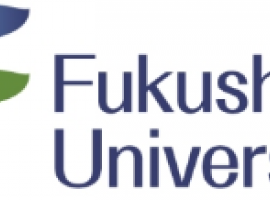
Partner 13: Fukushima University, Japan
Fukushima University is a national university located in Fukushima City, 58 km northwest of the Fukushima Daiichi Nuclear Power Plants. As the region‟s only national university, it has contributed to the revitalization efforts of the prefecture following the Great East Japan Earthquake by conducting research and surveys on topics requiring immediate attention. In April of 2011, it called for the implementation of the East Japan General Assistance Project (urgent survey and research topics), wherein a total of 35 survey and research topics were initiated under the program, in fields related to natural disaster science, disaster broadcasting, nuclear disaster prevention science, revitalization assistance, assisting children and disaster health and medicine. Through this project, the university supplied radiation dosage maps to relevant localities, assisted evacuated residents and raised issues associated with suspending production and delivery of farm produce.
Work for COMET will be undertaken by several research units: (1) Faculty of Symbiotic Systems Science, the key research group involved, has strong expertise in a) human support systems, including robotics and sensor technology, b) industrial systems, including decontamination techniques, and c) environmental systems management, including extremely small quantities analysis for water and environmental influences of radioactive substances. Its members have actively collaborated with organizations such as the Japan Atomic Energy Agency (JAEA), National Institute of Radiological Sciences (NIRS) and other Japanese Universities. (2) Fukushima Future Center for Regional Revitalization (FURE), established in 2011, supports the reconstruction of Fukushima from the standpoint of Economics, Administration, Education and Technology. FURE has a close relationship with local governments in Fukushima prefecture, and the relationship is beneficial for running investigations smoothly. (3) The Institute of Environmental Radioactivity, planned for establishment in 2013, will play the role of integrating results from investigations on the environmental influences of radiation following the Fukushima Daiichi Nuclear Power Plants accidents, in particular, in collecting several samples, e.g. soil, water, air-filter, plantation including crops and fruits, animals including cattle.
Staff members contributing to COMET:
Prof. Dr. Takayuki Takahashi, has 20 years experience in robotics including development of waterproof robots for radiation survey under ponds and lakes, and 3 years experience as the vice president of Fukushima university with strengthening the research organization management system of the university. He has been planning to establish the institute of environmental radioactivity in the university in order to research the various influences on the environment due to the Fukushima Daiichi Nuclear Power Plants accidents. He will contribute to the COMET project as a leader representing Fukushima University especially for WP1 and WP2.
Prof. Dr. Kenji Nanba, has 20 years experience in micro-biology including research on the influences of radioactive substances. After the Fukushima Daiichi Nuclear Power Plants accidents, he has energetically investigated water and soil contaminated with radioactivity through collaboration with many researchers in Japan. He will contribute to WP3 and WP4 based on a Fukushima area investigation.
Prof. Dr. Hirofumi Tsukada has 30 years experience in radioecology, with an emphasis on geochemistry and health physics, including: study on cycling and transfer mechanisms of the radionuclides in the atmospheric environment and in the soil-plant system, determination of transfer parameters and influencing soil properties, environmental risk assessment and counter-measures. He will contribute to WP3 and WP4.
Prof. Dr. Katsuhiko Yamaguchi has 20 years experience in solid state physics including the development of radiation sensors, e.g. Plastic Fiber Scintillation (PSF). He has applied the sensor technology to investigate radiation levels under ponds and lakes. He also progresses the education of radiation for general citizens including school students in Fukushima prefecture. He is the division leader of environmental energy including the radiation countermeasure section for FURE. He will contribute to WP3 and WP5 through sensor techniques and education methodology.
Prof. Kencho Kawatsu has 30 years experience in administration of nuclear power plants in Fukushima prefecture. He is the section leader of the radiation countermeasure department for FURE. He has coordinated relations between local governments and researchers while maintaining an adequate balance between the demands of local administration and research projects. He also has been integrating information concerned with decontamination of radioactive pollution. He will contribute to WP3 and WP5.
